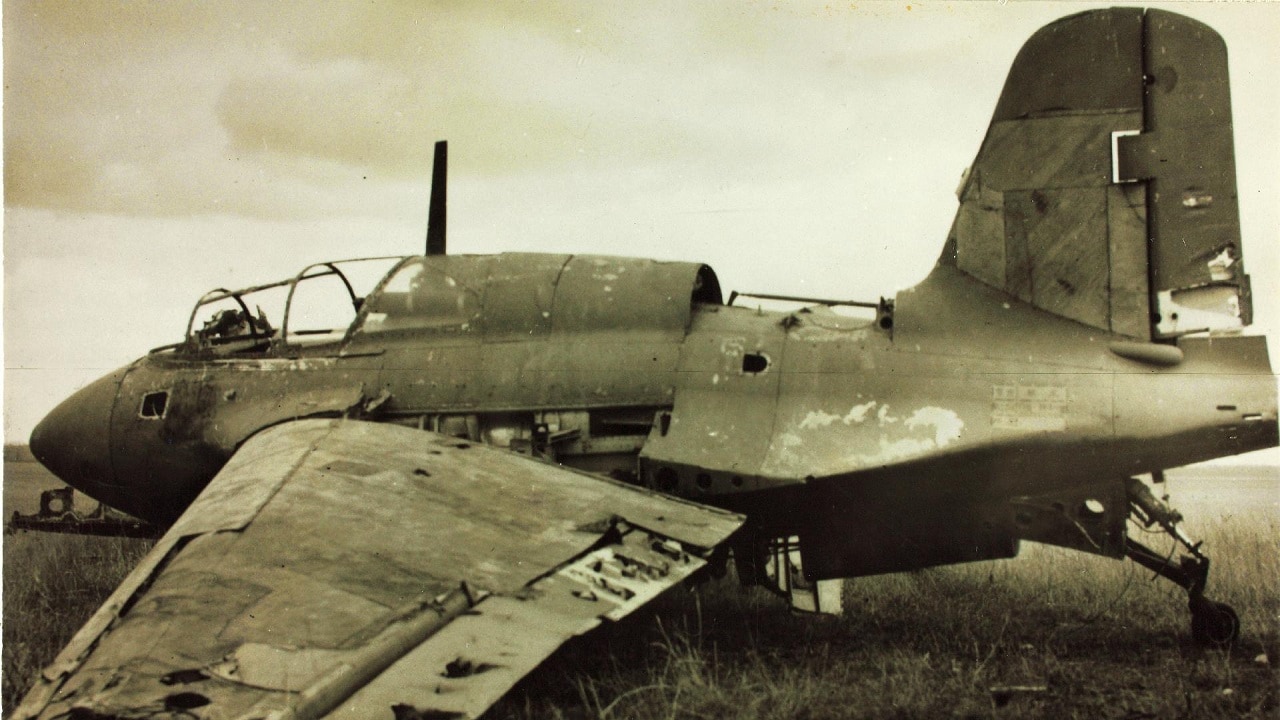We at 19FortyFive recently shared with you the story of the late WWII-era Nakajima Kikka. The aircraft was Imperial Japan’s first jet fighter, and it was directly inspired by Nazi Germany’s Messerschmitt Me 262 Schwalbe (Swallow), the world’s first operational jet fighter.
Not to be outdone, it turns out that Hideki Tojo’s aircraft engineer also drew inspiration from the world’s first operational rocket fighter, the German Messerschmitt Me 163 Komet. Say hello to the Mitsubishi J8M Shūsui, Japan’s first attempt at a rocket plane.
Mitsubishi J8M Shūsui Early History and Specifications
The Mitsubishi J8M Shūsui made her maiden flight on July 7, 1945, barely a month before atomic bombs were dropped on Hiroshima and Nagasaki. Production began the year prior, courtesy of Mitsubishi Heavy Industries, a company best known for building the famous Zero fighter plane.
Mindful of the pending B-29 Superfortess raids on their own homeland and the ongoing B-17 Flying Fortress and B-24 Liberator bombing raids against their German ally, Japanese military attaches in Berlin arranged to purchase manufacturing licenses for both the Me 163 Komet and its Walter HWK 109-509 rocket engine for the sum of 20 million Reichsmarks. But the U.S. Navy submarine USS Sawfish, and planes from the escort carrier USS Bogue, wrecked those plans, as they respectively sank the Japanese submarines RO-501 and I-29. The former Japanese sub was carrying a Komet airframe, while the latter boat ferried engines.
Hence Mitsubishi’s R&D folks were forced to wing it through reverse engineering, improvising from a basic instructional manual on the Me-163 conveniently obtained by naval mission member Comm. Eiichi Iwaya. The project became a joint venture between Imperial Japanese Army Air Service (JAAF) and the Imperial Japanese Navy Air Service (JNAF). The JAAF dubbed it the Ki-200, but it was the JNAF’s far catchier Shūsui moniker that stuck. The literal translation is “autumn water,” but Shūsui is used contextually as a poetic euphemism for “sharp sword,” referring to the swishing sound a samurai sword makes as it slices through the air.
Specifications included a fuselage length of 19 feet 10 inches, a wingspan of 31 feet 2 inches, a height of 8 feet 10 inches, an empty weight of 3,186 pounds, and a maximum takeoff weight of 8,547 lbs. Max airspeed was 559 miles per hour and cruise speed was 216 mph. By comparison, the Komet that the Japanese plane emulated had an official top speed of 623.8 mph and a cruise speed of 190 mph.
Armament consisted of two 30 mm Ho-105 cannon.
A total of seven J8Ms were built.
What Went Wrong, i.e. Too Little, Too Late for WWII
Unlike the Me 163, the J8M never saw combat. (The Kikka never saw combat either, unlike its Me 262 role model.) That aforementioned maiden flight turned out to be the only powered flight the Sharp Sword ever made, with test pilot Lt. Comm. Toyohiko Inuzuka at the controls.
As Dario Leone of Aviation Geek Club pointed out in a November 2018 article, this flight was performed “at a tremendous cost. Lt Cdr Inuzuka completed a successful rocket-powered takeoff, upon which the undercarriage dolly was jettisoned and the aircraft rocketed upward at a 45° angle. However, when the aircraft reached an altitude of 1,300ft, the engine shut down, causing the J8M1 to stall. Inuzuka was just moments away from successfully gliding the aircraft back to the airfield when he struck a small building near the runway and the J8M1 crashed and was consumed by flames. Inuzuka succumbed to his injuries the following day.”
From there: “All future J8M1 flights were postponed until the Ro.2 engine could be modified and the problem corrected. Flight testing was slated for resumption, as well as commencement of the development of the J8M2, when the war ended on Aug. 15, 1945.”
Where Are They (Is It) Now?
Two of the original seven J8Ms survive today. One is at the Planes of Fame Air Museum in Chino, California. It has the distinction of being the first aircraft acquired by that museum, courtesy of the U.S. Army Air Forces, who generously donated a captured specimen that had been housed at Wright Field, Ohio. The other is at Mitsubishi’s Minatomirai Industrial, Komaki Minami Factory Museum in Toyoyama-cho, Japan.
Model airplane builders, especially radio-controlled model aircraft enthusiasts, are in luck. A Durafly brand model J8M is available on the AIR-RC website. The product description notes that, “This plane is designed with the more experienced pilots in mind. The J8M Shusui has incredible flight performance and is stable throughout the complete speed range. Full power climb outs, virtually unlimited vertical, huge loops, blistering rolls and very fast passes are easily had at full throttle. At slower speeds, the J8M Shusui is just as stable with no hint of a stall.”
Christian D. Orr is a former U.S. Air Force Security Forces officer, Federal law enforcement officer, and private military contractor (with assignments worked in Iraq, the United Arab Emirates, Kosovo, Japan, Germany, and the Pentagon). Chris holds a B.A. in International Relations from the University of Southern California (USC) and an M.A. in Intelligence Studies (concentration in Terrorism Studies) from American Military University (AMU). He has also been published in The Daily Torch and The Journal of Intelligence and Cyber Security. Last but not least, he is a Companion of the Order of the Naval Order of the United States (NOUS).
RELATED: How To Sink A $3 Billion Dollar Submarine: Leave A Hatch Open
RELATED – Ukraine War Ending: Putin Sick with Cancer and Passes Away?

